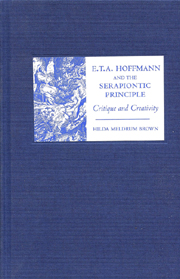Book contents
- Frontmatter
- Contents
- List of Illustrations
- Preface
- Acknowledgments
- List of Abbreviations
- Introduction: Approaches to the Serapiontic Principle
- Part 1
- 1 Overture: Jacques Callot
- 2 Der Einsiedler Serapion: The Formulation of a Principle
- 3 Der Dichter und der Komponist: Text and Music
- 4 Alte und neue Kirchenmusik
- 5 Prinzessin Brambilla: Callot Revisited
- 6 Epilogue: Des Vetters Eckfenster
- Part 2
- Conclusion
- Select Bibliography
- Index
1 - Overture: Jacques Callot
from Part 1
Published online by Cambridge University Press: 05 February 2013
- Frontmatter
- Contents
- List of Illustrations
- Preface
- Acknowledgments
- List of Abbreviations
- Introduction: Approaches to the Serapiontic Principle
- Part 1
- 1 Overture: Jacques Callot
- 2 Der Einsiedler Serapion: The Formulation of a Principle
- 3 Der Dichter und der Komponist: Text and Music
- 4 Alte und neue Kirchenmusik
- 5 Prinzessin Brambilla: Callot Revisited
- 6 Epilogue: Des Vetters Eckfenster
- Part 2
- Conclusion
- Select Bibliography
- Index
Summary
Hoffmann's first collection of tales, the Fantasiestücke, was published in four books between 1814 and 1816, and right from the start of his compilation in 1813 he adopted deliberate principles in the order and presentation of the individual works. Not yet at this point favoring the route taken by Goethe in his Unterhaltungen deutscher Ausgewanderten or Ludwig Tieck in his Phantasus, and which he himself would develop in Die Serapionsbrüder, of providing a frame narrative, he did not wish to throw his works before his public in a random fashion, either. Instead he adopted two unifying structural elements to place around the tales, first an overarching title: Fantasiestücke in Callots Manier: Blätter aus dem Tagebuch eines reisenden Enthusiasten, which he himself justified as having been deliberately chosen as a preface (“Vorrede”) to the succeeding tales. The second consisted in a succinct programmatic opening piece, Jacques Callot, in which he sought to provide his readership with what amounts to a concise statement of the artistic principles that he was proposing to adopt in the collection as a whole. In this connection it is relevant that several of the tales themselves were still taking shape at the point when the first two volumes had already been published (Der goldene Topf, for example, followed as volume 3 later in the same year, 1814, after the appearance of the first two books).
- Type
- Chapter
- Information
- E. T. A. Hoffmann and the Serapiontic PrincipleCritique and Creativity, pp. 21 - 32Publisher: Boydell & BrewerPrint publication year: 2006



